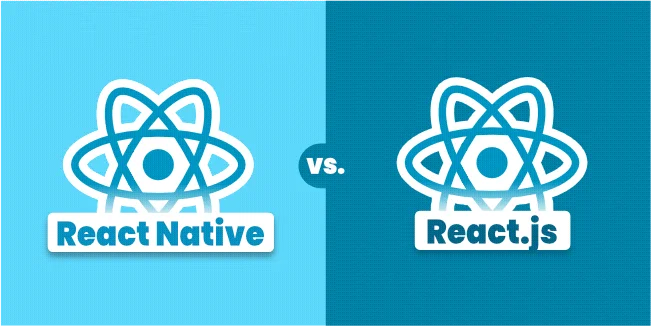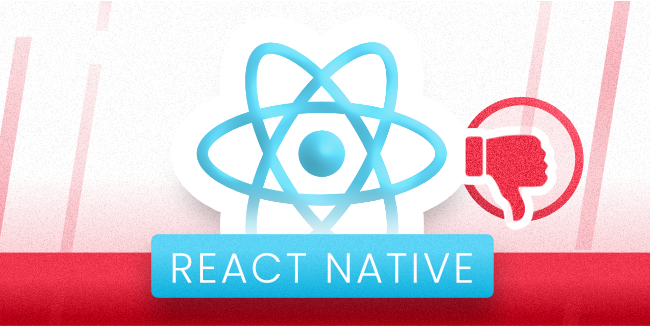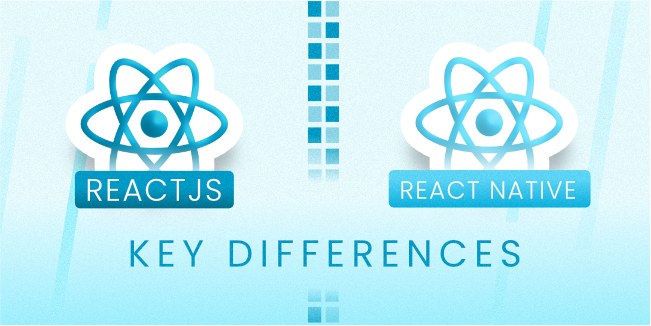React Native vs. React.js - Overview, Pros, Cons, and Key Differences

Both ReactJS and React Native were created by developers from the wing of the technological giant - Facebook (now Meta).
The names of these technologies are so similar that customers often ask us what the difference is between them.
The simplest answer is that React Native is used for building mobile applications, and React.js is responsible for making and rendering web interfaces.
However, it is not that simple. If you want to learn more about these technologies, their advantages, and how they differ, stay with us!
What is React Native?

React Native is an open-source Javascript-based framework built on top of React.js. It was created with the cross-platform development of mobile apps in mind. Applications developed with React Native were supposed to be indistinguishable from those built natively. That is why "Native" appears in its name.
Historically, React Native appeared in the minds of developers during an internal hackathon in 2013. It was supposed to solve the poorly functioning Facebook mobile application problems. These problems were caused by putting too much emphasis on the application created in HTML and the omission of a full-fledged mobile application.
React Native was first introduced in March 2015, while the last stable version was released in November.
What is React Native used for?
React Native framework is most often used to create cross-platform applications for the most popular mobile operating systems - Android and iOS. The React Native application has one code that works on iOS and Android.
This type of solution significantly speeds up time-to-market. It is much less expensive because developers have to create only one code and do not have to use several technologies.
Interestingly, using React Native, you can also create applications for Web, Windows, TVs, or even VR applications for Oculus. Wait a minute! At the beginning of this article, you wrote that React.js is used for Web development.
Yes, that's true, but if you want your application to work on iOS, Android, and the browser, React Native provides such a function.
Thanks to this, one code becomes the basis of both mobile and web apps.
Now let's look at the advantages and disadvantages of this framework!
React Native pros

The development process is fast
React Native was just created for fast mobile app development. It is built on React.js, i.e. the free front-end JavaScript library, and also has many complex third-party libraries of components and native modules. The components on which React Native operates are independent and reusable pieces of code.
With React Native components, building an application is sped up because React Native developers don't have to write new sections of code all the time, instead, they can reuse code components already used and use components that can be found in the aforementioned libraries. React Native can also compile native app components. Thanks to this solution, building an application is lightning fast.
Let's also not forget that React Native is used for building cross-platform apps - mobile, web, and TV. It allows you to build applications for different platforms from one code without rewriting the platform-specific code.
Great integration possibilities
React Native and Javascript codebases are already well established in the developers' community, and the number of users is only increasing. Thanks to that React Native has broader integration possibilities with external programs than any other framework.
It should also be mentioned that React Native compiles to the native code and can integrate with native APIs such as GPS or camera. Furthermore, third-party plugins - JavaScript or native ones - may be utilized too!
Such a wide possibility of integration makes React Native platform one of the best frameworks on the market.
Top-notch user interface and user experience
One of the most appealing aspects of React Native is the User Interface developed with it is always quick and responsive, regardless of the platform. React Native enables your application to utilize native elements such as buttons, bars, and icons on the mobile design.
Instead of separate components that work across both platforms, React Native considers native UI components and combines them with Javascript ones. The result? Apps appear and function like native mobile applications, giving a better user experience. The same screens on different platforms will differ by native UI elements.
React Native cons

Native apps are still faster
Applications built with just one platform in mind still outperform React Native in performance. It is related to, among others, native APIs, which in the case of native applications integrate naturally, while in the case of React Native, developers have to bridge them. It weighs down the application and makes the performance of React Native app differs from the natively built applications.
Components
Even though React Native libraries are huge and have a lot of useful reusable components in their resources, there may be a situation where you do not find the component you are interested in. It will mean that the code will have to be rewritten from scratch.
What is React.js?

We already have basic information about React Native Now it's time to look at the solution on which this framework was built - React JS. React JS, or "React" as it is often referred to, is an open-source front-end library that creates user interfaces.
As the name suggests, React is based on JS - JavaScript. Similar to React Native, React JS also operates on components.
Considering the popular software design pattern - Model View Control (MVC), React JS is responsible for "View," everything the user sees in the application.
The initial prototype of React was named "FaxJS," and it was developed in 2011 by Facebook's software developer Jordan Walke. In 2013, it entered the public domain at the JavaScript conference.
What is React.js used for?
We as React development company can create both web and mobile apps with ReactJS. In its structure, ReactJS uses code intended for web development (HTML), so although it can be used to create a mobile application, our natural choice for mobile development is the mobile framework - React Native.
Web applications developed with React JS have beautiful and transparent User Interfaces, so most of the applications developed are dynamic Single Page Applications (SPA). Single Page Application requires no page reloading, and the majority of its information remains the same while only some of it needs to be refreshed. The SPA updates content using JavaScript APIs when required.
Each of us knows this scheme, we go to Facebook, Instagram, and in the background, we have a Netflix web app running. All of these services were built with React JS, and all of them are Dynamic Single Page Applications!
Now let's look at the advantages and disadvantages of React JS.
React.js pros

Components
As we mentioned, React JS, similar to React Native, is based on components that accelerate development and are also used to create great User Interfaces. Facebook introduced components to make developers' life easier.
That is why component implementation affects only one element in an app, not the whole structure. It also helps save time since it reduces the number of debugging cycles required. Time saved equals money saved and a quicker time to market.
Virtual DOM
As we have already noticed, Facebook with its "React" family, solves many problems in a classic development. Virtual React DOM is another example of this. The Document Object Model (DOM) is in charge of the entire logical structure of the application's components and how they are accessed and handled.
The traditional DOM is built on a tree structure, so if something below it changes, the application may be negatively affected. On the other hand, react JS's Virtual DOM allows for virtual modifications to the DOM.
It implies that before the user sees the changes, the algorithm examines where these should be made and how they can be done best. Only then are actual modifications to the application's DOM implemented. Long story short - vDOM reloads only necessary elements of the application.
It guarantees improved performance and user experience.
Great community
React JS is an OPEN-SOURCE javascript library. Thanks to the fact that this solution is free, has many great features, and is supported by Facebook makes it one of the most popular technologies on the market. On GitHub alone, this solution has over 150,000 stars.
Thanks to such a large community, new tools and solutions appear every day to help other developers at work. In addition, such high popularity is collateral. Nobody in their right mind will stop supporting the much-loved technology.
React.js cons

Still at development
React JS is constantly developing like many technologies on the market, and its structure has changed. Therefore, this can be a downside, especially for new developers who are just getting to know the technology.
It can be tiring for experienced developers because sometimes they have to learn the same functions repeatedly. Sometimes there are also big changes, for example, in 2017, when the old rendering algorithm, Stack, was replaced by React Fiber.
Not a complete solution
As we said earlier, React JS in the structure of Model View Control is responsible only for a view layer. You will need to use other technology such as PHP or Java for the whole backend. However, it also means that the application could be better structured and that every project developed with React JS will differ.
ReactJS vs React Native - key differences

Type of tool
ReactJS is a library, whereas React Native is a framework. So, what's the difference between these two? A framework is more complicated than a library. It includes the control flow and many white spaces where developers can add code.
A library comprises class definitions and components that must be compiled and integrated into the system. Libraries may be plugged into frameworks, which is how ReactJS and React Native are linked.
Displaying
As you already know React JS uses Virtual DOM to display elements of an app. React Native, on the other hand, does not use DOM because that is strictly connected with HTML. Instead, React Native uses native APIs for rendering User Interface elements.
When it comes to displaying the code for the developer, instead of HTML tags such as
, the developer sees tag, which can be compiled into native code.
The purpose
React JS is mainly used to develop web pages and web applications. It is because React JS works with JavaScript code combined with HTML code. Due to the nature of this solution, it is mainly used for web development.
React Native, on the other hand, was created mainly for cross-mobile platform development. It uses JavaScript to create native-like applications.
Interestingly, 85% of the code can be shared between mobile platforms (common logic). The remaining 15% is specific to a given platform, e.g., Android or iOS.
Which React to choose?
There are no winners in the React vs. ReactJS competition. It all depends on your project.
If you want a native mobile app that should work on multiple platforms, choose React Native because it was meant for mobile development.
If you want to create a web application, ReactJS is the answer. However, remember that you will also need backend technology!
We at mDevelopers use solutions from React family to create innovative and high-quality mobile and web applications. Get in touch with us if you want one!